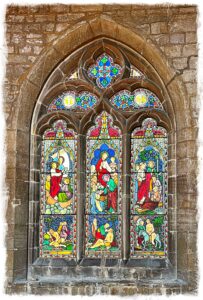St. Peter and St. Paul’s Church, Gosberton
The North Aisle contains five windows, as shown from west to east on the illustration above. They are numbered for reference.
Windows no. 1 & 2
These, the most westerly of the five windows, have modern, plain, glazing, with diamond-shaped leading. Unlike the other windows in the church, they can be fairly precisely dated – to between 1436 and 1450 – when the church was extended westward, the windows being situated in that extension. Whereas the windows themselves are of little interest to the visitor, there are items placed on their sills which are worthy of note.

On the sill of Window no. 1 is a stone carving of a head. This is most likely to have been one of the many such decorative heads that can be seen dotted around the exterior and interior of the church, around arches, niches and doorways. Presumably this particular example was removed during one of the church’s renovation works, and placed, incongruously, here on the window sill. It looks in good condition, so it is a mystery as to why it wasn’t re-incorporated into the building.
On the sill of Window no. 2 is a stone plaque which reads “ ST. PETER’S ROOM. THIS SITE WAS THE GIFT OF THE REV. A.J. SANGSTER THROUGH WHOSE EFFORTS THIS HALL WAS ERECTED IN 1963.” St. Peter’s Room was a separate building, situated on the north side of the churchyard, functioning as a church hall. Reverend Sangster was the Vicar here from 1958 until 1981. St. Peter’s Room was extended in 1974, but unfortunately the building was short lived. It was found to have been built on unsafe foundations and so was demolished in 1993. It was replaced with the current church hall in 1996.
Window no. 3
This small window, above the North Door, is, like the previous two windows, plainly glazed with diamond leading. Look closely and you will see a dove carrying an olive branch in the central tracery – a symbol of peace, love and hope.
Window no. 4

This window, like Window no. 5, houses stained glass which, although Victorian in age (rather than the medieval originals), are nonetheless artworks that can be appreciated for their great beauty (despite Walter Jenkinson Kaye, in his 1897 book ‘A Brief History of the Church and Parish of Gosberton’ describing the stained glass in the church as “modern and of no particular merit”).
Window no. 4 shows scenes from the New Testament; Mary Magdalene weeping at Christ’s tomb, Christ blessing the children, and Christ appearing to Mary Magdalene in the Garden. It was glazed in memory of members of the Dods family, in this case Henry Dods, who died age 48 in 1863, and his 11 year old son Henry Water Dods, who died in 1859.
Window no. 5

The most easterly window shows scenes of Christ’s miracles; Christ stilling the tempest, the feeding of the five thousand, the raising of the widow’s son and the parable of the Good Samaritan. The window glazing bears the inscription “In affectionate and grateful remembrance of William and Ann Dods.” This most probably refers to Gosberton farmer and grazier William Dods, who resided at ‘Marsh Bank’ (what we call Gosberton Bank today), who died in 1838, and his wife Ann (nee Spurr) who died in 1862. Both were buried in Gosberton churchyard, just below this very window.
The Entrepreneurial Dods Family
As well as endowing the church with the glazing in windows 4 and 5, members of the Dods family are commemorated on two memorial wall plaques here in the North Aisle. Proof, indeed, that they were influential.
The Dods of Gosberton were farmers and graziers, and were a branch of the more successful and influential Dods of Donington, who had links to that village for over 200 years, and were over the years land and property owners, coal and corn merchants, road stone merchants, animal feed and manure merchants, boat owners, farmers. maltsters, brewers, wine and spirit merchants, public-house owners, attorneys, insurance agents and general traders, employing near to one hundred men at the peak of their business empire.
